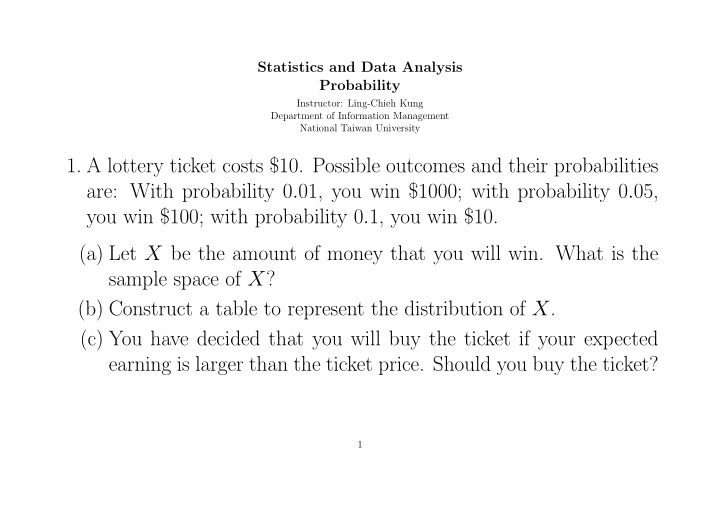



Statistics and Data Analysis Probability Instructor: Ling-Chieh Kung Department of Information Management National Taiwan University 1. A lottery ticket costs $10. Possible outcomes and their probabilities are: With probability 0 . 01, you win $1000; with probability 0 . 05, you win $100; with probability 0 . 1, you win $10. (a) Let X be the amount of money that you will win. What is the sample space of X ? (b) Construct a table to represent the distribution of X . (c) You have decided that you will buy the ticket if your expected earning is larger than the ticket price. Should you buy the ticket? 1
2. Let X be the number of people who visit a particular web page in the next hour. (a) Suppose that the distribution of X is estimated to be 50 150 250 350 450 550 650 x Pr( X = x ) 0 . 3 0 . 2 0 . 2 0 . 1 0 . 1 0 . 05 0 . 05 Find µ = E [ X ], the expected number of next-hour visitors. Note. The MS Excel sheet “Given X’s distribution” contains the distribution information. (b) Find σ 2 = Var( X ), the variance of the next-hour visitors. 2
3. On a web page, there is a slot for display advertisement. Let X be the number of next-hour visitor to this page, whose distribution is 50 150 250 350 450 550 650 x Pr( X = x ) 0 . 3 0 . 2 0 . 2 0 . 1 0 . 1 0 . 05 0 . 05 Suppose that the click-through rate (CTR) is 0 . 02, i.e., given any customer, the probability for her to click the advertisement is 2%. That CTR is identical for everyone. (a) Let Y be the number of customers who will click the advertise- ment. How would you find the distribution of Y ? Is it easy? (b) Find E [ Y ], the expected value of Y . How do you find it from E [ X ]? 3
4. Consider a random variable X whose pdf is � 4 if 0 ≤ x ≤ 1 3 x f ( x ) = . 4 − 8 if 1 < x ≤ 3 3 x 2 (a) Draw the pdf. Does f (1) = 4 3 mean Pr( X = 1) = 4 3 ? (b) Find Pr( X ≤ 1 2 ). (c) Find Pr( X ≥ 1). (d) Show Pr( X ≤ 3 2 ) = 1. Is this a coincidence? 4
5. Let D be the daily demand of a certain product. It is typical to use a normal distribution to approximate the distribution of D . Let D ∼ ND(100 , 20), i.e., D is normally distributed with mean 100 and standard deviation 20. (a) Find Pr( D ≤ 100) without using software. (b) Find Pr( D ≤ 90). (In MS Excel: NORM.DIST() ) (c) Find Pr( D ≤ 82). (d) Find Pr( D ≥ 96). (e) Find Pr(110 ≤ D ≤ 130). (f) Find Pr( D ≤ 70)+Pr( D ≥ 130). Compare it with 2 Pr( D ≤ 70). 5
6. Let D ∼ ND(100 , 20) be the daily demand of a certain product. (a) Find a value q 1 such that Pr( D ≤ q 1 ) = 0 . 4. (In MS Excel: NORM.INV() ) (b) Find a value q 2 such that Pr( D ≤ q 2 ) = 0 . 6. Is q 2 = 200 − q 1 ? Why or why not? (c) Find an order quantity q that achieves 90% of service level for the next day, i.e., the probability to have no shortage in a day is 90%. (d) For service levels 10%, 20%, ..., and 90%, find the corresponding order quantities. Plot them to illustrate how these quantities changes as the desired service level increases. 6
7. Let X ∼ ND(30 , 5), Y ∼ ND(10 , 2), and Z ∼ ND(0 , 1). Note that Z is a standard normal random variable. (a) Find Pr( X ≤ 25), Pr( Y ≤ 8), and Pr( Z ≤ − 1). Show that they are all the same. (b) In MS Excel, use NORM.S.DIST() to calculat Pr( Z ≤ − 1). Then use NORM.S.INV() to find z such that Pr( Z ≤ z ) = 0 . 16. 7
Recommend
More recommend